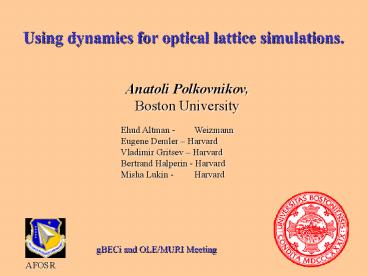Using dynamics for optical lattice simulations. PowerPoint PPT Presentation
Title: Using dynamics for optical lattice simulations.
1
Using dynamics for optical lattice simulations.
Anatoli Polkovnikov, Boston University
Ehud Altman - Weizmann Eugene Demler
Harvard Vladimir Gritsev Harvard Bertrand
Halperin - Harvard Misha Lukin - Harvard
gBECi and OLE/MURI Meeting
AFOSR
2
Cold atoms (controlled and tunable Hamiltonians,
isolation from environment)
1. Equilibrium thermodynamics
Quantum simulations of equilibrium condensed
matter systems
- Simulation of phases and phase-transitions for
complicated many-particle systems. - Testing various analytical and numerical
approaches to many-body problems. - Better understanding and engineering strongly
correlated materials.
3
2. Quantum dynamics
Quantum simulation of behavior of non-equilibrium
many-body systems.
Importance current technology approaches quantum
limits.
Challenges experimental hard to realize solid
state systems sufficiently isolated from
environment theoretical huge (exponentially
large) Hilbert space, lack of methods.
- Potential
- understanding fundamental problems related to
integrability, thermalization, quantum chaos,
quantum measurement, - using out of equilibrium effects as a tool to
simulate equilibrium properties of interacting
systems.
4
This talk.
- Phase diagram of a moving condensate in an
optical lattice. - Response of generic gapless systems to slow ramp
of external parameters. - Quench dynamics in coupled one dimensional
condensates.
5
M. Greiner et. al., Nature (02)
Adiabatic increase of lattice potential
What happens if there is a current in the
superfluid?
6
Drive a slowly moving superfluid towards MI.
7
Meanfield (Gutzwiller ansatzt) phase diagram
Is there current decay below the instability?
8
Role of fluctuations
Phase slip
Below the mean field transition superfluid
current can decay via quantum tunneling or
thermal decay .
9
Related questions in superconductivity
Reduction of TC and the critical current in
superconducting wires
Webb and Warburton, PRL (1968)
Theory (thermal phase slips) in 1D Langer and
Ambegaokar, Phys. Rev. (1967)McCumber and
Halperin, Phys Rev. B (1970) Theory in 3D at
small currents Langer and Fisher, Phys. Rev.
Lett. (1967)
10
1D System.
N1
Experiment C.D. Fertig et. al., 2004
Large N102-103
Numerical prediction A.P. D.-W. Wang, 2003
Fallani et. al., 2004
11
Higher dimensions.
Longitudinal stiffness is much smaller than the
transverse.
r
Need to excite many chains in order to create a
phase slip.
12
Phase slip tunneling is more expensive in higher
dimensions
13
Current decay in the vicinity of the
superfluid-insulator transition
Discontinuous change of the decay rate across the
mean field transition. Phase diagram is well
defined in 3D!
Large broadening in one and two dimensions.
14
Detecting equilibrium SF-IN transition boundary
in 3D.
p
Easy to detect nonequilibrium irreversible
transition!!
At nonzero current the SF-IN transition is
irreversible no restoration of current and
partial restoration of phase coherence in a
cyclic ramp.
15
J. Mun, P. Medley, G. K. Campbell, L. G.
Marcassa, D. E. Pritchard, W. Ketterle, 2007
16
Adiabatic process.
Assume no first order phase transitions.
17
Adiabatic theorem for integrable systems.
Density of excitations
18
Adiabatic theorem in quantum mechanics
Landau Zener process
In the limit ??0 transitions between different
energy levels are suppressed.
This, for example, implies reversibility (no work
done) in a cyclic process.
19
Adiabatic theorem in QM suggests adiabatic
theorem in thermodynamics
- Transitions are unavoidable in large gapless
systems. - Phase space available for these transitions
decreases with d.Hence expect
Is there anything wrong with this picture?
Hint low dimensions. Similar to Landau expansion
in the order parameter.
20
More specific reason.
- Equilibrium high density of low-energy states
-gt - strong quantum or thermal fluctuations,
- destruction of the long-range order,
- breakdown of mean-field descriptions,
Dynamics -gt population of the low-energy states
due to finite rate -gt breakdown of the adiabatic
approximation.
21
Three regimes of response to the slow ramp
- Mean field (analytic) high dimensions
- Non-analytic low dimensions
- Non-adiabatic lower dimensions
22
Example crossing a QCP.
? ? ? t, ? ? 0
Gap vanishes at the transition. No true adiabatic
limit!
How does the number of excitations scale with ? ?
23
Possible breakdown of the Fermi-Golden rule
(linear response) scaling due to bunching of
bosonic excitations.
24
Finite temperatures.
25
Results.
26
T0.02
27
Thermalization at long times.
28
2D, T0.2
29
Quench experiments in 1D and 2D systems
T. Schumm . et. al., Nature Physics 1, 57 - 62
(01 Oct 2005)
Study dephasing as a function of time. What sort
of information can we get?
30
(No Transcript)
31
Analogy with a Josephson junction.
Simulations
b02
Hubbard model, 2x6 sites
b24
2b01
b46
b04
2b02
b26
32
Conclusions.
- Phase diagram of a moving superfluid in optical
lattices - Quantum (and thermal) phase slips in low
dimensions. - Accurate probe of the equilibrium phase diagram
in high dimensions. - Slow dynamics in gapless systems
- universal response near second-order phase
transitions (critical exponents, KZ mechanism,
). - possible breaking of the adiabatic limit in low
dimensions. It is crucial to have large scale
isolated systems for experimental verification. - Possibility of probing spectral properties of
integrable and weakly non-integrable models in
quench experiments.

